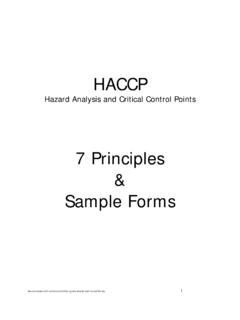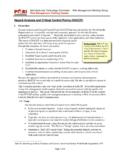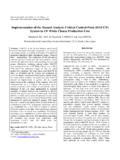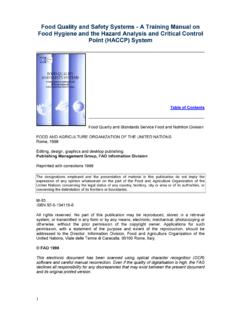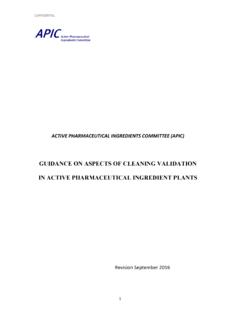Transcription of Economics of Trading Advisory Council
1 Economics of Trading Advisory Council Economics of Trading Advisory Council MEMbErsMEMbErsRuss Baxter, Virginia Department of Environmental QualityJoshua Duke, University of DelawareJohn Hines, Pennsylvania Department of Environmental Protection (through Feb, 2012)Peter Hughes, Red Barn ConsultingCy Jones, World Resources InstituteDoug Lipton, University of MarylandCarl Lucero, Department of AgricultureBeth McGee, Chesapeake Bay FoundationChris Pyke, Green Building CouncilJohn Rhoderick, Maryland Department of AgricultureAnn Roda, Pennsylvania Department of Environmental ProtectionPat Thompson, EnergyWorks, Varner, Troutman Sanders, LLPRob Wood, Environmental Protection AgencyEPA LiAisonsEPA LiAisonsKevin DeBell.
2 Environmental Protection AgencyGary Shenk, Environmental Protection AgencyPrEPArEd forPrEPArEd forChesapeake Bay CommissionPrEPArEd byPrEPArEd byGeorge Van HoutvenRoss LoomisJustin BakerRobert BeachSara CaseyrTi inTErnATionALrTi inTErnATionAL3040 Cornwallis RoadResearch Triangle Park, NC 27709nutrient Credit Tradingnutrient Credit Trading for the Chesapeake bayfor the Chesapeake bayAn Economic StudyMAY 2012annapolis, maryland richmond, virginia harrisburg, pennsylvaniaannapolis, maryland richmond, virginia harrisburg, pennsylvaniaTo Our Readers: The Chesapeake Bay Commission is a policy leader in the restoration of the Chesapeake Bay.
3 As a tri-state legislative commission representing the General Assemblies of Maryland, Pennsylvania and Virginia, its mission is to identify critical environmental needs, evaluate public concerns and advance state and federal actions to improve water quality and sustain the living resources of the Chesapeake Bay. One of the responsibilities the Chesapeake Bay Commission exercises in fulfilling its mission is to provide policy research and options to its member states in their Chesapeake Bay restoration efforts.
4 This report examines the Economics of nutrient credit Trading . Trading is one tool among many designed to achieve pollution reduction goals. All three member states of the Chesapeake Bay Commission are already implementing Trading programs as part of their efforts to reduce the excess levels of nitrogen and phosphorus that are polluting local waters and the Chesapeake Bay. This report does not offer a critique of the state programs. Instead, it generates data from which sound policy can evolve. It offers a foundational economic analysis that provides insights into how markets can minimize the cost of pollution reductions, with cost being one of several factors for policymakers to consider.
5 The members of the Economics of Trading Advisory Council were instrumental in assuring the accuracy and applicability of this work to our region. The Council s advice, coupled with the extraordinary expertise of the contractors, made the project possible. RTI International researched and prepared this report. RTI is an independent, nonprofit institute that provides research, development, and technical services to government and commercial clients worldwide. Its mission is to improve the human condition by turning knowledge into practice.
6 HOPE Impacts managed the development of the project, providing expertise on policy and technical issues as well as drafting and editing. Roy A. Hoagland, Esq., is the principal/owner of HOPE Impacts and partners with nonprofits, foundations, and government agencies on complex issues facing Chesapeake Bay restoration. The Linden Trust for Conservation provided the funding for the research, preparation, and development of this report. As part of its mission, it seeks to advance the use of conservation finance and environmental markets in ways that address major environmental challenges.
7 The Commission thanks The Linden Trust for its investment in, and commitment to, a healthier Chesapeake Bay. We thank you one and all, Emmett W. Hanger, Jr. Virginia Senator, District 24 & Chairman, Chesapeake Bay CommissionTable of ContentsTable of Contents List of Abbreviations 44 section 1section 1 Introduction 55section 2section 2 Sources of Nutrient Loads and the Bay TMDL 88section 3section 3 Nutrient Trading : A Strategy for Encouraging Cost-Effective Reductions in Nutrient Loads 1212section 4section 4 Framework for Analyzing the Potential Cost Savings from Nutrient Trading to Meet the Bay TMDL 1515section 5section 5 Nutrient Trading Scenarios 2222section 6section 6 Additional Conditions and Restrictions on Nutrient Trading 2525section 7section 7 Load Reduction Targets (Steps 1 Through 4)
8 3131section 8section 8 Inventory of Nutrient Control Projects (Steps 5 Through 6) 3434section 9section 9 Potential Cost Savings from Trading (Steps 7 Through 9) 4141section 10section 10 Caveats and Uncertainties 5151section 11section 11 Conclusion 5454 References 5656 These Appendices may be found at These Appendices may be found at Appendix A: Methods for Estimating Significant Point Source Costs and Load ReductionsAppendix B: Methods for Estimating Agricultural BMP Costs and Load ReductionsAppendix C: Methods for Estimating Urban Stormwater BMP Costs and Load ReductionsAppendix D: Optimization ModelAppendix E: Tradable Loads to Avoid Local Tidal Water Quality Impact Appendix F.
9 Additional Results 44 NUTRIENT CREDIT Trading FOR THE CHESAPEAKE BAYList of AbbreviationsList of Abbreviations AgrNPS agricultural nonpoint sourcesBMPs best management practicesCAFOs concentrated animal feeding operationsCBPO Chesapeake Bay Program OfficeCBWM Chesapeake Bay Program Phase Watershed ModelCRP Conservation Reserve ProgramCSO combined sewer overflowENR enhanced nutrient removalEPA Environmental Protection AgencyMGD million gallons per dayMS4 municipal separate storm sewer systemNRCS Natural Resources Conservation ServiceO&M operation and maintenanceSigPS significant point source dischargersTMDL Total Maximum Daily LoadWIPs Watershed Implementation PlansWLAs waste load allocationsWWTPs wastewater treatment plants AN ECONOMIC STUDY MAY 2012 55 introductionintroductionThe Chesapeake Bay ecosystem is under stress.
10 Among an onslaught of pressures, the primary cause of this stress is the overabundance of nutrients flowing into its rivers, streams, and estuaries. The two main nutrients nitrogen and phos-phorus are naturally occurring substances that are essential for living organisms. However, large amounts of these nutrients, most often generated by human activity, result in excess algae growth. This excess algae depletes oxygen from the water, blocks sunlight for under-water plants, and upsets the functioning of a healthy aquatic ecosystem.


